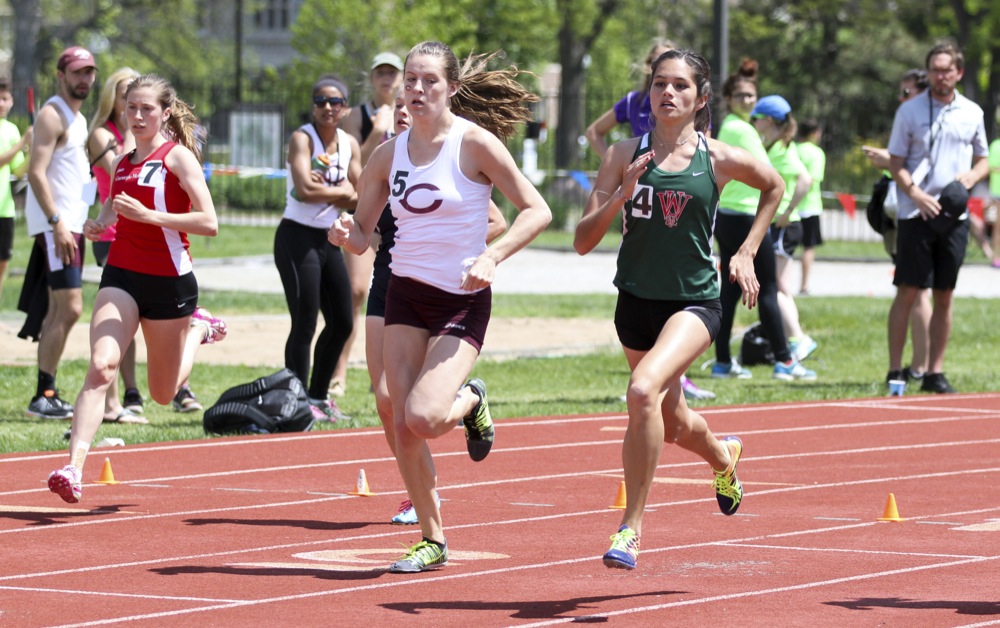This past Sunday, neighborhood track phenom Daisy Ogede strained her left quad and elected to sit out her final three events of the conference championship meet. Yet, you may not have noticed the junior’s absence, given the final tally. Even without Ogede, the Washington University women’s track and field team still managed to shellac the rest of the UAA, scoring 48 points more than No. 16 Emory University and 59.5 more than No. 23 University of Chicago.
The Bears’ victory was so complete for the same reason they’re now No.1 in the national rankings: depth.
As counterintuitive as it may sound, depth determines the success of a collegiate track team far more than any one star runner, jumper or thrower. That’s because track meets are decided on a point system where teams can earn points from finishing anywhere from first to eighth in any one event. First place gets ten points, second gets eight, third seven, fourth six—and you get the idea.
 Skyler Kessler | Student Life
Skyler Kessler | Student LifeSophomore Annalise Wagner runs in the 800-meter dash at the UAA Track and Field Tournament last weekend.
So imagine two teams, team Mark Wrighton and team Holden Thorp. Team Wrighton has one All-American runner; she’s so good that she’s been featured on ESPN and has met Barack Obama. Everyone else on that team is terrible, though. Team Thorp on the other hand, has nine OK runners—they’re good, not great. All 10 athletes qualify to compete in the 100m dash, and as you’d probably expect, Team Wrighton wins. But, before you crown victor, count the point total. Wrighton earns 10 for first place, but Throp wins a whopping 29 with second through eighth.
Now, the Bears won their fair share of events this weekend, nine to be exact, but that only accounts for 90 points. The other 131 came from being competitive in practically every single event. Of the 21 events that were scored, the Bears placed in 20. And of those 20, only four times did the Bears finish without a runner higher than sixth. The 5,000m race was the only event where the Bears did not place. And before you fire Stiles and declare the Bear’s season dead, it’s worth mentioning that sophomore Aly Wayne did not compete. Wayne earned third place in the 5000m at Indoor nationals about six weeks ago.
Beating up on UAA teams is one thing, but to earn a No. 1 national ranking and make good on that come NCAA Outdoor Championships, you need a deep stable of runners who can compete at the national level. Don’t worry, the Bears have that too.
First, there is Ogede. We all know she’s fast, but the margin between her and her peers is staggering. A day before tweaking her quad in the 100m hurdle, she clocked in at 11.78 in the 100m dash. That’s the fastest time in Division III this year by one 10th of a second or, in other words, the difference between first and fifth in the 2004 Olympics. She’s also set the high bar in the 200m and ranks seventh in the nation in the 100m hurdles. She’s also a member of both of the Bears’ all-Division relay teams, but more on that later.
Behind Ogede, there is a healthy list of runners who could earn points for the Bears come nationals in late May. There is junior Kelli Hancock, who owns the fastest 400m hurdle in Division III, senior Emily Warner, who’s eighth in the 400m, sophomore Annalise Wagner, who clocks in at third for the 800m, Wayne, who’s sixth in the 10000m, sophomore Alison Lindsay, at 4th in the 3000m steeplechase, and, finally, junior Rebecca Ridderhoff, who is just over two seconds behind Hancock in the 400m hurdle.
Just beyond this upper tier is another crop of runners and field athletes who race on the cusp of national notoriety. One such Bear is freshman Elise Grever, who currently holds the 28th and 19th best times in Division III in the 100m and 200m, respectively.
Unsurprisingly, top individual runners become top relay units. Grever, Hancock, Warner and Ogede posted the top 400m-relay time in Division III during UAA’s. Ridderhoff, Hancock, Wagner and Warner also earned that distinction in the 1600m relay.
As further testament to the Bears’ depth, Wagner subbed into the 1600m relay on short notice after Ogede tweaked her quad. That new unit proceeded to break the conference mark by six seconds. Now, Stiles gets to decide what unit he wants to stick with: the one with a three-time UAA Most Outstanding Performer, or the one that just embarrassed a conference record.
With so many runners primed to compete at the national level come late April, it’s no wonder the Bears have now catapulted to the top of the rankings by a wide point margin. The U.S. Track and Field and Cross Country Coaches Association uses a computer algorithm that takes in data such as race times and outputs a point total. The more points you have, the higher you’re ranked. Right now, the Bears have 190.23 points, over 50 more than second place Nebraska Wesleyan University. For context, that’s a little less than the difference between Nebraska and number seven.




















